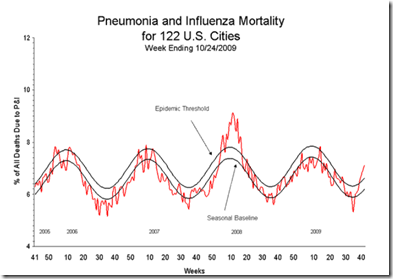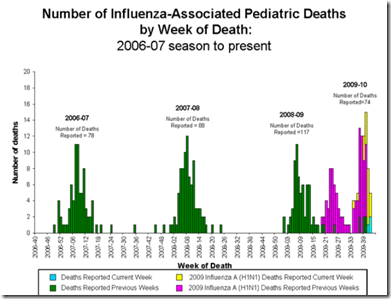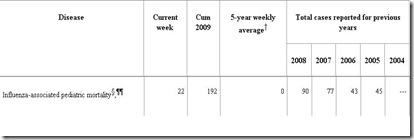# 3911
The question as to whether statins – commonly used cholesterol lowering drugs – might play a positive role in the treatment of influenza and pneumonia is one that we’ve discussed numerous times over the years.
We’ve seen a see-sawing of opinion, driven by a parade of conflicting studies. Today we’ve new research to look at, but first a review of the recent past.
Dr. David Fedson was probably the first to champion the idea of using statins for an influenza pandemic. In his paper on the subject, published in July of 2006.
Pandemic Influenza: A Potential Role for Statins in Treatment and Prophylaxis
David S. Fedsona
The next influenza pandemic may be imminent. Because antiviral agents and vaccines will be unavailable to people in most countries, we need to determine whether other agents could offer clinical benefits. Influenza is associated with an increase in acute cardiovascular diseases, and influenza viruses induce proinflammatory cytokines.
Statins are cardioprotective and have anti-inflammatory and immunomodulatory effects, and they thus might benefit patients with influenza.
In 2007 we saw a study that seemed to support the idea, that indicated that statins lowered the mortality rate of people with pneumonia.
Statin drugs lower respiratory death risk: study
Tue Apr 10, 2007 12:40pm EDT
By Maggie Fox, Health and Science Editor
WASHINGTON (Reuters) - People who use statin drugs are less likely to die of influenza and chronic bronchitis, according to a study that shows yet another unexpected benefit of the cholesterol-lowering medications.
Their study of more than 76,000 people showed that those who had taken statins for at least 90 days had a much lower risk of dying from chronic obstructive pulmonary disease or COPD, the technical name for emphysema and chronic bronchitis.
Dr Fedson and Peter Dunnill, DSc,FREng then collaborated on a commentary, published in the Permanente Journal, Summer 2007 edition, on how we might confront an imminent pandemic.
The commentary was called New Approaches to Confronting an Imminent Influenza Pandemic, and in it the authors presented options including two possible routes to producing vaccine in quantity, and the use of statins to mitigate the effects of a cytokine storm.
(More on Dr. Fedson at the bottom of this blog)
In January of 2008, Australian researchers announced encouraging results from studies conducted on mice given gemfibrozil, a fibrate, which is another class of cholesterol lowering drug.
And just a year ago, in October of 2008, we learned:
Statins may cut pneumonia death, blood clot risks
27 Oct 2008 20:00:13 GMT
Source: Reuters
By Will Dunham
WASHINGTON, Oct 27 (Reuters) - Cholesterol-fighting drugs known as statins reduced the risk of dying from pneumonia or developing dangerous blood clots in the legs, adding to a growing list of benefits from the popular drugs, two research groups said on Monday.
Statins, the world's top-selling drugs, cut heart attack and stroke risk, and research has suggested other benefits including possibly protecting against Alzheimer's disease.
Of course, not all of the news was positive.
Just last July we heard that there were no signs of benefit among pneumonia patients (see Another Take On Statins And Pneumonia), where I reported on this story:
British Medical Journal study includes 3,000 Group Health patients
SEATTLE— Taking popular cholesterol-lowering statin drugs, such as Lipitor® (atorvastatin), does not lower the risk of pneumonia. That's the new finding from a study of more than 3,000 Group Health patients published online on June 16 in advance of the British Medical Journal's June 20 print issue.
"Prior research based on automated claims data had raised some hope—and maybe some hype—for statins as a way to prevent and treat infections including pneumonia," said Sascha Dublin, MD, PhD, a physician at Group Health and assistant investigator at Group Health Center for Health Studies. "But when we used medical records to get more detailed information about patients, our findings didn't support that approach."
Conflicting medical studies are nothing new. We see them all the time. Science is often messy and we get to the truth by fits and starts – and that can sometimes take years.
Today we’ve news of new research on statins, presented at the annual meeting of the IDSA, the Infectious Diseases Society of America, in Philadelphia.
Maryn McKenna writing for CIDRAP brings us the details.
Maryn McKenna  Contributing Writer
Contributing Writer
Oct 29, 2009 (CIDRAP News) – Commonly available drugs that are sold in lower-cost generic versions improve the survival of patients hospitalized for seasonal influenza, researchers reported today, raising the possibility of a widely available treatment that could be used in a severe flu pandemic if other drugs are in short supply.
The research, by the US Centers for Disease Control and Prevention (CDC) and scientists in several states, is part of a slate of new flu reports being presented this weekend at the annual meeting of the Infectious Diseases Society of America (IDSA) in Philadelphia. Also on the agenda: findings that flu vaccination of pregnant women has a protective effect on their babies both before and after birth, and news of what may be the first person-to-person transmission in the United States of H1N1 flu strains resistant to antiviral drugs.
The research presented Thursday examined the effect of the cholesterol-lowering drugs called statins on the clinical course of people who were already taking the drugs and then were hospitalized with lab-confirmed flu infections in the 2007-08 flu season. Those who were already on statins were half as likely to die, Meredith Vandermeer of the Oregon Public Health Division said during a press briefing at the state of the meeting.
The patients were identified via surveillance in 10 states conducted by the CDC’s Emerging Infections Programs; data on their lab results, prescriptions and outcome were drawn from reviews of their medical records. There were 2,800 lab-confirmed cases of flu in the surveillance results, Vandermeer said; 801 of those patients were recorded as taking statins during their hospital stay, presumably because they had been prescribed them before admission. Among the 2,800, 17 people who were on statins died, versus 64 were not on statins. Proportionally, that is 2.1% of those on statins and 3.2% of those not taking the drugs—a risk reduction of approximately half, Vandermeer said.
(Continue . . .)
Maryn’s article has additional details, plus reports on vaccine benefits in pregnant women, and the transmission of resistant H1N1 at a summer camp. Follow the link to read it in it’s entirety.
While not conclusive, this latest study offers some additional tantalizing evidence that statins might someday play a role in the treatment of influenza and pneumonia.
Further studies and controlled trials are needed, of course, before we can know for sure.
* * * * * * * * * * *
Dr. David Fedson, will be interviewed again on Radio Sandy Springs by Sharon Sanders of Flutrackers, at 4pm on Monday, Nov 2nd. You can listen online, or download the archived show later in the week.
Sharon interviewed Dr. Fedson last may, and you can listen to that archived show at 05/18/09 Guest Dr. David Fedson.








